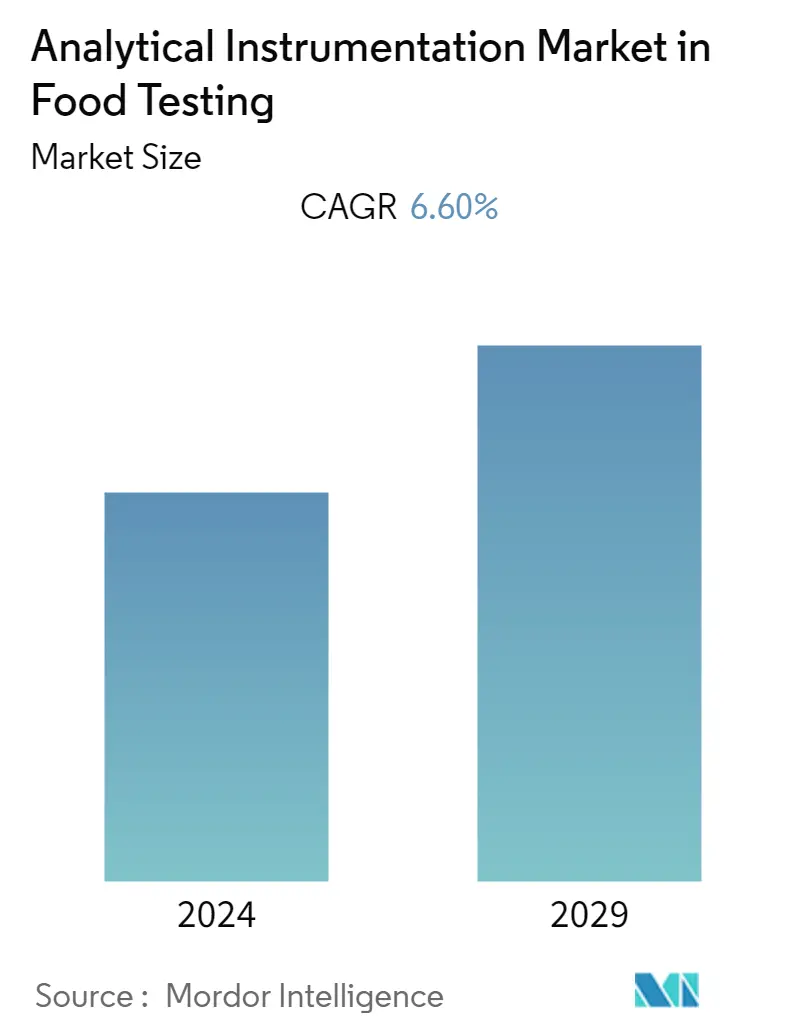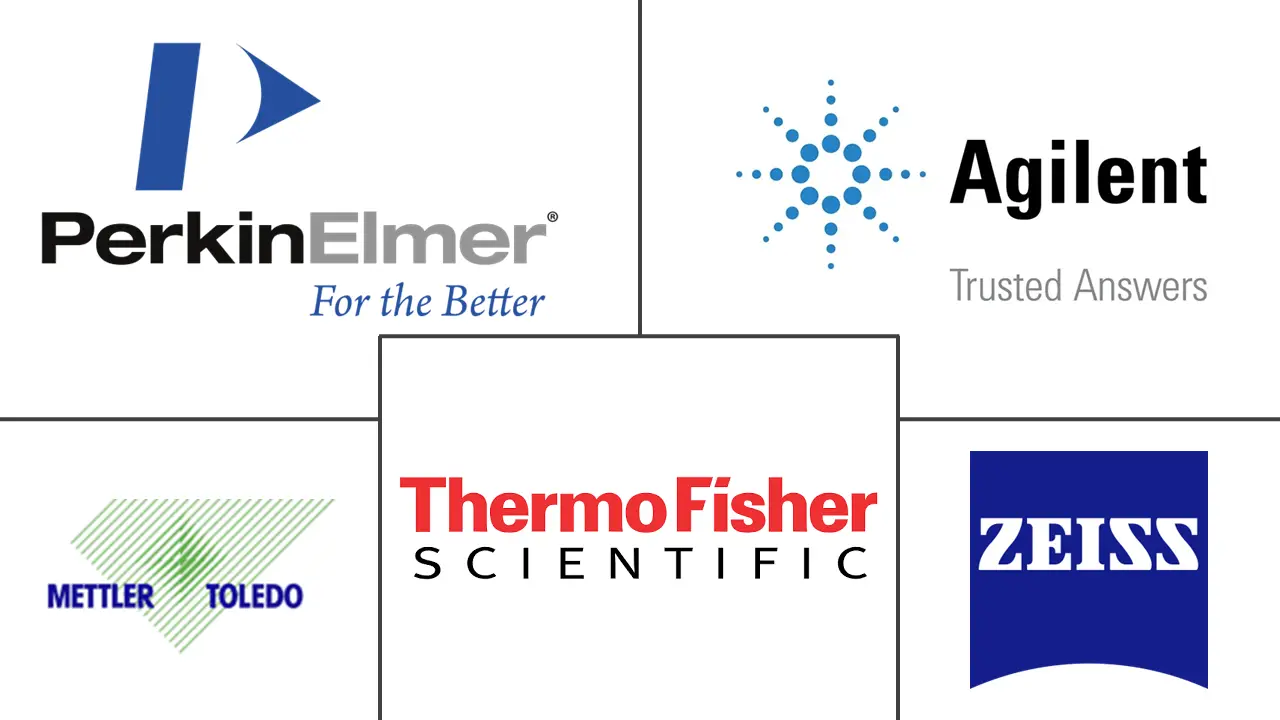Market Size of Analytical Instrumentation Industry in Food Testing

| Study Period | 2019 - 2029 |
| Base Year For Estimation | 2023 |
| CAGR | 6.60 % |
| Fastest Growing Market | Asia-Pacific |
| Largest Market | North America |
| Market Concentration | Medium |
Major Players
*Disclaimer: Major Players sorted in no particular order |
Food Testing Analytical Instrumentation Market Analysis
The analytical instrumentation market in food testing is anticipated to record a CAGR of 6.6% during the forecast period. The food industry requires analytical instrumentation solutions for various reasons, such as verifying the shelf-life, authenticity, maintenance of food safety, and regulatory compliance. Food manufacturing companies are adopting analytical instrumentation solutions worldwide with new food safety challenges and issues.
- The most common analytical methods used in the food and beverage industry are for monitoring and testing food safety, nutrition, and quality. These tests include chemical, microbiological, and physical contaminants to achieve compliance with local, national, and international regulations. Food contamination causes severe damage to the consumer and the brand's reputation. The increasing investments in the food processing industry are expected to act as a major driver for adopting analytical instrumentation solutions.
- Several companies in the market are striving to advance their existing technologies and integrate new technologies to enable augmented efficiency in food testing. For instance, in February 2022, Agilent Technologies acquired advanced AI technology developed by Virtual Control, an AI and ML software developer that creates innovative and efficient analysis solutions in lab testing. Agilent may integrate the software, known as ACIES, into its gas chromatography and mass spectrometry (GS/MS) platforms to improve the productivity and accuracy of high-throughput labs served by the company globally. Several industries, such as food testing, agriculture, environmental, and applied materials, are claimed to benefit from Agilent's acquisition of the technologies.
- Numerous companies are also launching new products to cater to the evolving and complex needs of their customers. For instance, in June 2022, PerkinElmer announced the launch of its new GC 2400 Platform, an automatic gas chromatography (GC) headspace sampler and GC/mass spectrometry (GC/MS) solution for food safety analyses intended to help technicians simplify laboratory operations, obtain precise results, and perform flexible monitoring. The platform integrates systems, software, various columns, and consumables for high-throughput laboratory environments and complex applications.
- The scope of analytical instrumentation has further expanded for food applications. Clinical diagnostic testing is emerging as a significant application as it was a considerable bottleneck during the COVID-19 pandemic. Vendors offered various solutions for the detection of COVID-19. For instance, recently, PerkinElmer Inc. launched two COVID-19 environmental testing kits to help food processors and contract labs detect the presence of SARS-CoV-2 on surfaces such as food plants. The company also launched a series of explorer workstations for SARS-CoV-2 testing, capable of preparing and running up to 10,000 COVID-19 tests per day using analytical instruments.
- However, the maintenance costs and other indirect expenses increased the total cost of ownership of these analytical instruments. According to LabCE, the maintenance, reagents, supplies, controls, calibration, and depreciation costs result in USD 3.61 per test. Thus, the high cost of analytical instruments is an important factor restraining the market's growth. However, in the mass spectrometry segment, the cost and size of mass spectrometers may reduce while the instrument's capabilities may increase. Mass spectrometers with high sensitivity and resolving power are available in sizes suitable for liquid and gas chromatographs.
Food Testing Analytical Instrumentation Industry Segmentation
Food analytical instrumentation facilitates ascertaining product quality, checking compliance with national and international food standards, implementing regulatory enforcements, contracting specifications and nutrient labeling requirements, etc.
The analytical instrumentation market in food testing is segmented by technique (chromatography, spectroscopy) and geography.
| By Technique | |
| Chromatography | |
| Spectroscopy | |
| Other Techniques (Material Characterization, Liquid Analyzers, X-ray Instrumentation, and Analytical Microscopes) |
| By Region | |
| North America | |
| Europe | |
| Asia-Pacific | |
| Rest of the World |
Analytical Instrumentation Market in Food Testing Size Summary
The analytical instrumentation market in food testing is experiencing steady growth, driven by the increasing need for food safety, quality assurance, and regulatory compliance. This market is characterized by the adoption of advanced analytical methods to monitor and test for chemical, microbiological, and physical contaminants. The food industry is leveraging these technologies to address new challenges and ensure the integrity of food products. Companies are investing in innovative solutions, such as gas and liquid chromatography, to enhance the sensitivity and accuracy of tests. The integration of AI and machine learning technologies is also playing a significant role in improving the efficiency of food testing processes. Despite the high costs associated with these instruments, the demand is bolstered by the expanding food processing industry and the need for robust testing solutions.
In the Asia-Pacific region, the market is witnessing significant developments due to increased investments in research and development, particularly in countries like India. Collaborations between industry players and research institutions are fostering innovation and expanding the application of analytical instrumentation in food testing. The market is moderately fragmented, with key players like Agilent Technologies, PerkinElmer, and Thermo Fisher Scientific leading the charge in introducing advanced products and solutions. These companies are focusing on enhancing product offerings to meet the complex demands of the food industry, including the need for rapid and accurate testing methods. The ongoing advancements in technology and the strategic partnerships being formed are expected to drive the market's growth in the coming years.
Analytical Instrumentation Market in Food Testing Market Size - Table of Contents
-
1. MARKET INSIGHTS
-
1.1 Market Overview
-
1.2 Value Chain Analysis
-
1.3 Industry Attractiveness-Porter's Five Forces Analysis
-
1.3.1 Threat of New Entrants
-
1.3.2 Bargaining Power of Buyers
-
1.3.3 Bargaining Power of Suppliers
-
1.3.4 Threat of Substitute Products
-
1.3.5 Intensity of Competitive Rivalry
-
-
1.4 Impact of COVID-19 on the Market
-
-
2. MARKET SEGMENTATION
-
2.1 By Technique
-
2.1.1 Chromatography
-
2.1.2 Spectroscopy
-
2.1.3 Other Techniques (Material Characterization, Liquid Analyzers, X-ray Instrumentation, and Analytical Microscopes)
-
-
2.2 By Region
-
2.2.1 North America
-
2.2.2 Europe
-
2.2.3 Asia-Pacific
-
2.2.4 Rest of the World
-
-
Analytical Instrumentation Market in Food Testing Market Size FAQs
What is the current Food Testing Analytical Instrumentation Market size?
The Food Testing Analytical Instrumentation Market is projected to register a CAGR of 6.60% during the forecast period (2024-2029)
Who are the key players in Food Testing Analytical Instrumentation Market?
PerkinElmer Inc., Thermo Fisher Scientific, Agilent Technologies Inc., Mettler Toledo International Inc. and ZEISS International are the major companies operating in the Food Testing Analytical Instrumentation Market.

